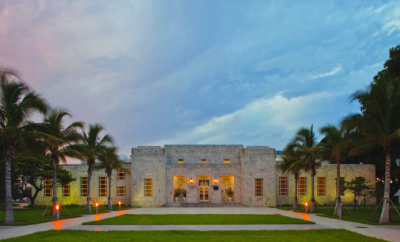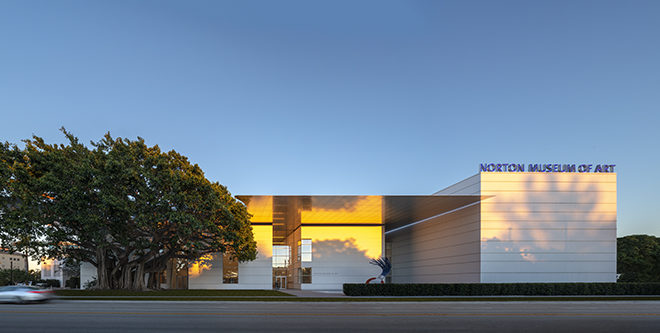 The Norton Museum of Art’s new Kenneth C. Griffin Building, designed by Foster + Partners, as seen from S. Dixie Highway. PHOTO © NIGEL YOUNG / FOSTER + PARTNERS.
The Norton Museum of Art’s new Kenneth C. Griffin Building, designed by Foster + Partners, as seen from S. Dixie Highway. PHOTO © NIGEL YOUNG / FOSTER + PARTNERS.
Design
The Norton Museum celebrates Foster-designed expansion
South Florida, no longer a cultural backwater, has enjoyed a surge of new and renovated arts institutions over the past several years. In February, another impressive project made its debut in West Palm Beach, with a major transformation of the Norton Museum by architect Lord Norman Foster and his London-based firm, Foster + Partners.
The Norton has been a Palm Beach treasure since it opened in 1941, a gift from Chicago industrialist Ralph Hubbard Norton and his wife, Elizabeth Calhoun Norton, who wintered in the community and commissioned architect Marion Syms Wyeth to design a museum to house their art collections. The one-story art deco building became known for its exceptional collections of Chinese jades and bronzes and American realist paintings, and new wings were added in 1995 and 2001 to accommodate new acquisitions. But the institution continued to outgrow the building, which lost the integrity of its original, courtyard-centered plan.

The Norton Museum of Art’s new Heyman Plaza, designed by Foster + Partners, featuring Typewriter Eraser, Scale X (1999) by Claes Oldenburg and Coosje Van Bruggen. PHOTO © NIGEL YOUNG / FOSTER + PARTNERS.
The latest expansion is the result of a three-year building project that added a 59,000-square-foot wing, reorganized the fragmented space, created a striking new entrance, and converted a parking lot into an inviting sculpture garden that will also enable the museum to add outdoor programming to its community activities. In addition to expansive new galleries, the Norton now has a state-of-the-art, 210-seat auditorium, an expanded education center and student gallery, and a spacious sky-lit Great Hall intended as a “living-room” gathering-place for visitors. The renovation project also included a gift shop and a restaurant, neither of which the museum had before, as well as the restoration of a row of six 1920s cottages along one side of the garden, providing facilities for an artist-in-residence program and a home for the museum director.
The new plan involved substantially demolishing the building interiors, rearranging galleries, and reorganizing space along axes to recover the original symmetrical plan, as well as installing new lighting and updating technical facilities.
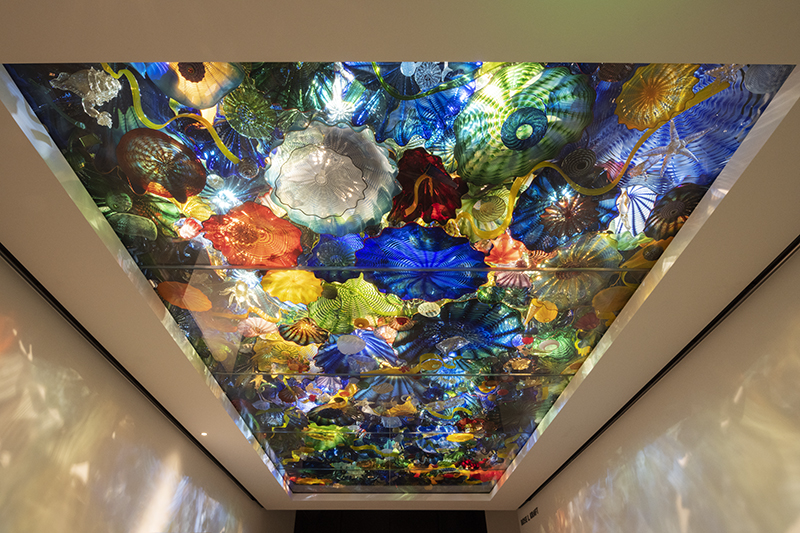
Installation view of Dale Chihuly’s Persian Sea Life Ceiling (2003) at the Norton Museum of Art. PHOTO © NIGEL YOUNG / FOSTER + PARTNERS.
The exterior of the new three-story building is white stucco, punctuated horizontally with aluminum strips. The main entrance, on the opposite side from the original canal-side approach, now faces a major highway, making the museum more visible to drivers. Its grand plaza was designed to accommodate an existing eighty-year-old Banyan tree. To one side, a Claes Oldenburg-Coosje van Bruggen Typewriter Eraser (1999) sits lightly on a shallow reflecting pool. A recent gift to the museum, the sculpture, and its various iterations, is the subject of one of eight special exhibitions in the museum as part of the inaugural celebration.
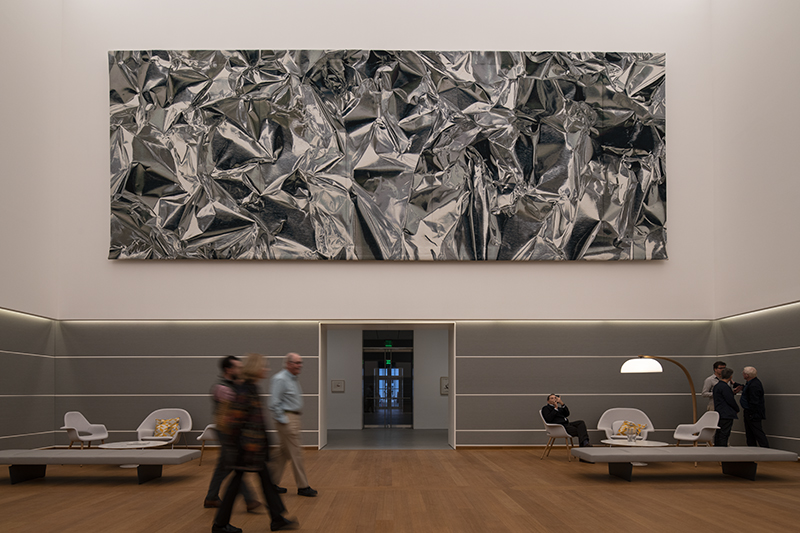
Pae White’s Eikón, a 40-foot-long, 15-foot-tall tapestry in the Norton Museum of Art’s new Ruth and Carl Shapiro Great Hall, designed by Foster + Partners. PHOTO © NIGEL YOUNG / FOSTER + PARTNERS.
From the plaza, visitors enter the Great Hall, an airy, oak-floored, forty-three-foot-high space that is both reception and gathering area, with comfortable seating and a huge window looking out to the Banyan tree. A specially commissioned fifteen-by-forty-foot tapestry by artist Pae White in rich colors forms the focal point of the space. Other attention-getting works are strategically deployed in key areas: a Rob Wynne installation, composed of 6,000 pieces of hand-poured glass suggesting the surf and marine life, runs along the staircase; a Paul Morrison painting of tropical flowers along three walls of a special-events space; and a vivid Dale Chihuly ceiling between two galleries. In the reconfigured space, way-finding is comfortable, and the layout permits views across the span of the building to the Intracoastal Waterway beyond.
The garden, Foster’s first, is strategically aligned with the axis of the museum galleries, creating the illusion of extended gallery spaces accessed through floor-to-ceiling glass doors. He transformed 37,200-square-feet space, with two “rooms,” a walkway, a picnic area, and secluded shaded enclaves. Interspersed throughout are fourteen outdoor sculptures. A rich mix of plants and trees incorporates blooming tropical foliage that provides visual and olfactory appeal.
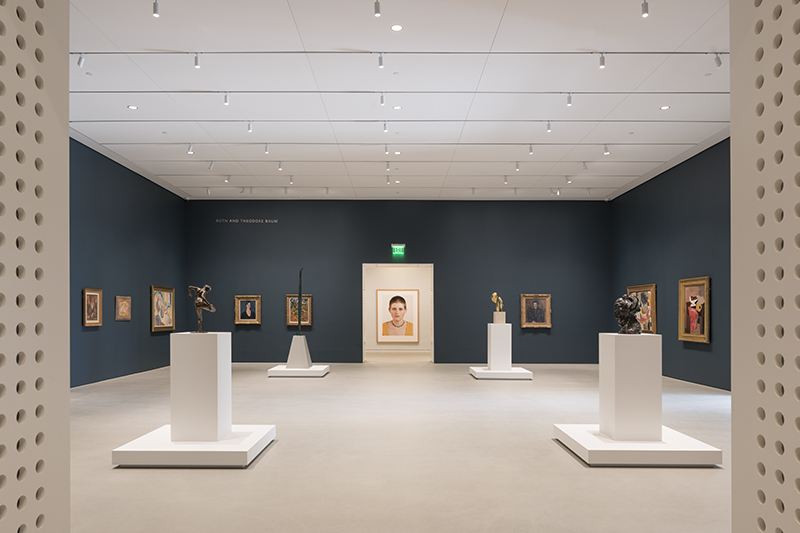
Installation view at the Norton Museum of Art. PHOTO © NIGEL YOUNG / FOSTER + PARTNERS.
The museum’s permanent collection includes more than 7,600 works in five curatorial departments: American, Chinese, Contemporary, European, and Photography.
There are approximately a thousand American paintings, sculptures, and works on paper, concentrating on the early twentieth century. Among those collected by the Nortons are paintings by George Bellows, Edward Hopper, Georgia O’Keeffe, and Charles Sheeler as well as sculptures by Gaston Lachaise, William Zorach, and Paul Manship—whose Diana and Actaeon was purchased to adorn the facade of the original building. After Norton’s death in 1953, paintings by Stuart Davis, Jackson Pollock, and others have added to the range of American artists represented.
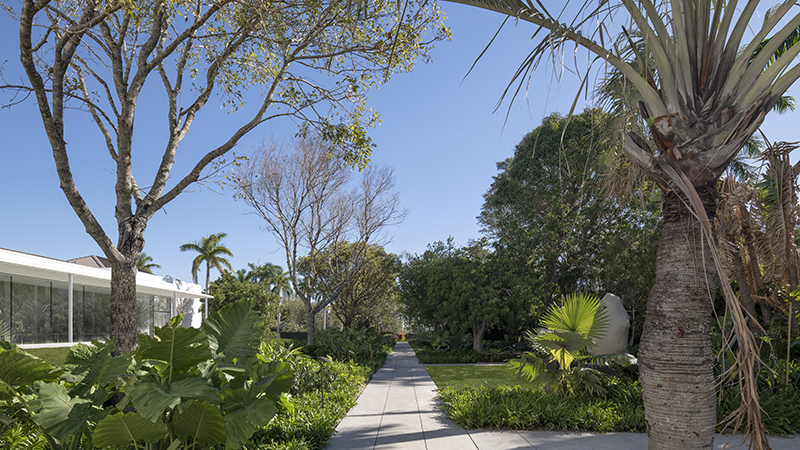
The Norton Museum of Art gardens, looking east. PHOTO © NIGEL YOUNG / FOSTER + PARTNERS.
European and American masters are represented in a photography collection of more than 4,500 works that spans the history of the medium, among them Alexander Rodchenko, Laszlo Moholy-Nagy, Bernd and Hilla Becher, and contemporary artists such as Thomas Demand and Candida Hofer.
Some of the inaugural presentations highlight artwork owned by South Florida collectors, camera-less photography, portrait photography, watercolors, and a group of Chinese Lantern Festival paintings. For visitors to South Florida, the renovated Norton seems destined to be a must-see.



